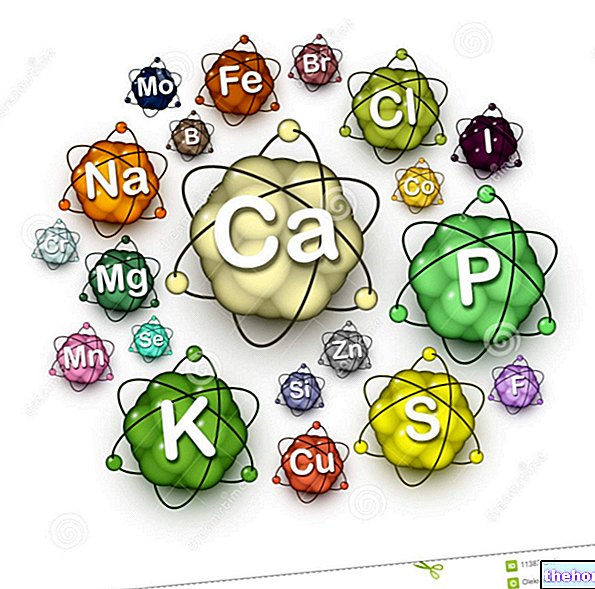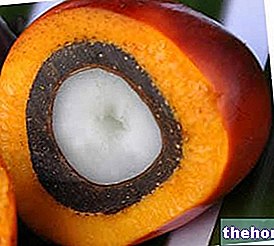Functions
VITAMIN A (retinol or axerophtol), derives from a precursor, beta carotene, a provitamin that is transformed by the organism, in turn a precursor of the retinal, a group that absorbs light in visual pigments. It is essential for epithelial cells, for the growth of the skeleton and teeth, for the normal sexual maturation of the adolescent and the fertility of the adult; in addition, it increases the defense of infections.

Vitamin A A is "more active in the presence of vitamins C and E. Beta carotene also protects against" excessive sun exposure and has antioxidant activity; it is transformed into vitamin A according to the needs of the organism, which eliminates the substance present in excess.
VITAMINS D, defined antirachitic, represent a group of vitamins consisting of D2 or ergocalciferol; D3 or cholecalciferol; D4 or dihydrocalciferol. Vitamins D2, D3 are produced in the skin by the action of ultraviolet rays on the provitamins ergosterol (of vegetable origin) and 7-dihydrocholesterol (of animal origin). Vitamin D is transformed in the kidney into hormone-vitamin D which regulates the metabolism of calcium and phosphorus by interacting with parathyroid hormone and calcitonin for bone calcification.
Vitamin E (alpha tocopherol) is considered the antioxidant vitamin par excellence, especially in the metabolism of unsaturated fatty acids. Its antioxidant activity is reinforced by the simultaneous presence of vitamin C, glutathione and selenium.
VITAMIN K (acronym that derives from the initial of the Danish term coagulation) or anti-haemorrhagic vitamin. It was isolated for the first time in alfalfa in the 1930s. It is distinguished in K1 or phylloquinone and K2 or menaquinone. Promotes blood clotting , contributing to the synthesis of various factors and in particular of prothrombin To be active, vitamin K must bind to its apoenzyme (gamma-glutamylcarboxylase) in the liver.
Functions of water-soluble vitamins
VITAMIN B1 (so-called because it was the first vitamin of the group to be discovered), or thiamine. It is a precursor of thiamine pyrophosphate (TPP) which is part of pyruvate carboxylase, an enzyme complex that catalyzes the transformation of pyruvate into acetyl-CoenzymeA (energy mechanism)
VITAMIN B2. It is also called lactoflavin (due to being isolated for the first time in milk) or riboflavin (due to the presence of the yellow-green pigment linked to a ribose molecule). It is a precursor of FAD, a group of flavin coenzymes or flavo proteins ( conjugated proteins consisting of a protein part and riboflavin) which participate in the respiratory chain, therefore involved in metabolic processes concerning the use of energy.
Vitamin B6 or pyridoxal or pyridoxamine. It is a group of vitamins precursor of pyridoxalphosphate, which is part, as a coenzyme, of various enzymatic systems such as transaminases. This vitamin stimulates brain and nervous functions, participates in the biosynthesis of amino acids, hemoglobin and erythrocytes. It favors the use of selenium and the production of antibodies, protecting the body from diseases and premature aging.
VITAMIN B3 or vitamin PP or niacin or nicotinic acid is part of the coenzymes of various dehydrogenases such as NADH. It protects the skin, promotes blood circulation, the functionality of the digestive system, the synthesis of sex hormones, cortisol, insulin, thus involving various metabolic processes.
VITAMIN B5 or pantothenic acid. It is a component of coenzyme A and can also derive from tryptophan, whose transformation is in turn regulated by vitamin B6. It favors the energy use of food and the synthesis of many organic substances, keeps skin and hair healthy.
VITAMIN B9 or folic acid (due to the presence in vegetables or large green leaves where it was initially found) is part of a coenzyme involved in the synthesis of purines and some amino acids, including methionine. It is therefore a fundamental vitamin for DNA. It is particularly important in pregnancy for the correct development of the embryonic nervous system. A deficiency can lead to anemia, common in pregnancy (20%) with a risk of newborns with spina bifida (malformation of the spinal column) and / or cleft lip. Vitamin B9 is also very important to counteract the negative effects of homocysteine.
VITAMIN B12 or cyanocobalamin, so called for its structure with a cobalt atom in the center, is part of the cobamide coenzymes. This vitamin is absorbed in the small intestine and its absorption is allowed by an intrinsic factor (glycoprotein secreted by the gastric mucosa essential for the absorption of vitamin B12); these two compounds complex to form the erythrocyte maturation factor, which is essential for the maturation of red blood cells in the bone marrow. It is involved in the synthesis of DNA, it regulates the metabolism of carbohydrates, lipids and proteins. The dysfunctions linked to this vitamin can therefore depend on both a direct deficiency and a deficiency of intrinsic factor.
VITAMIN H (always belonging to the B vitamins is also called biotin from bios, a factor that facilitates levitation. This vitamin is a component of an enzymatic system that contains proteins (biocytin); it joins with covalent bond to the carboxylases carrying CO2 groups; it regulates the synthesis of hemoglobin, consequently affecting the transport of O2 in the blood; promotes cell growth and the production of energy from amino acids
VITAMIN C or acorbic acid, owes its name to the ability to treat scurvy, a disease that mainly affected ship crews who for long periods were unable to obtain supplies of fresh vegetables. Vitamin C is a reducing agent in hydroxylation reactions, such as in the conversion of proline of collagen to hydroxyproline. It is an adjuvant in the incorporation of iron into ferritin (iron-free anemia). It is an antioxidant agent which acts in synergy with vitamins A and E and with selenium; stimulates the immune system; improves the integrity of the capillary walls; reduces the damage caused by nitrites and nitrates present in food preservatives, lowering the risk of formation of potentially carcinogenic nitrosamines.
For further information: Vitamins: excess and deficiency. For further information: Vitamins: deficiency and overdosing



























